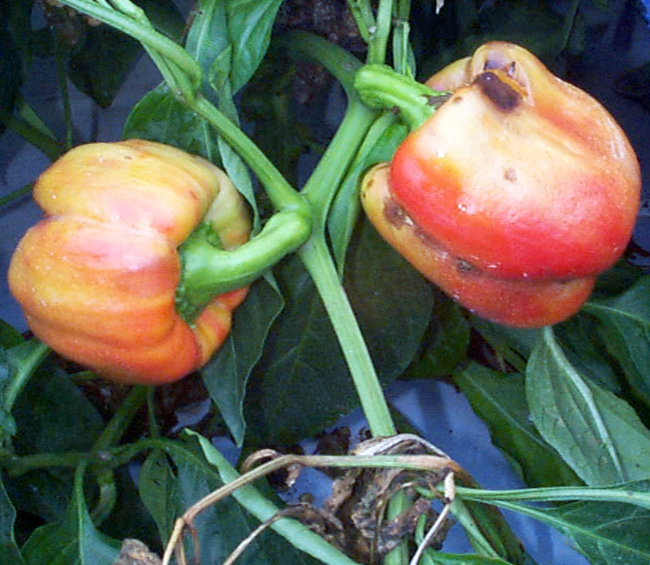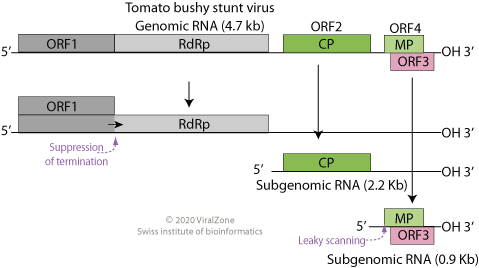|
Maize Chlorotic Mottle Virus
''Machlomovirus'' is a genus of plant viruses, in the family '' Tombusviridae''. Plants serve as natural hosts. There is only one species in this genus: ''Maize chlorotic mottle virus'' (MCMV), which causes significant losses in maize production worldwide. MCMV was first identified in the U.S. state of Kansas causing Maize lethal necrosis disease/MLN/corn lethal necrosis, a severe disease that negatively affects all stages of development for maize plants. Structure Viruses in ''Machlomovirus'' are non-enveloped, with icosahedral and spherical geometries, and T=3 symmetry. The diameter is around 28-34 nm. Genomes are linear, around 4–5.4kb in length. Life cycle Viral replication is cytoplasmic. Entry into the host cell is achieved by penetration into the host cell. Replication follows the positive stranded RNA virus replication model. Positive stranded RNA virus transcription, using the premature termination model of subgenomic RNA transcription is the method of tran ... [...More Info...] [...Related Items...] OR: [Wikipedia] [Google] [Baidu] |
Plant Virus
Plant viruses are viruses that affect plants. Like all other viruses, plant viruses are obligate intracellular parasites that do not have the molecular machinery to replicate without a host. Plant viruses can be pathogenic to higher plants. Most plant viruses are rod-shaped, with protein discs forming a tube surrounding the viral genome; isometric particles are another common structure. They rarely have an envelope. The great majority have an RNA genome, which is usually small and single stranded (ss), but some viruses have double-stranded (ds) RNA, ssDNA or dsDNA genomes. Although plant viruses are not as well understood as their animal counterparts, one plant virus has become very recognizable: ''tobacco mosaic virus'' (TMV), the first virus to be discovered. This and other viruses cause an estimated US$60 billion loss in crop yields worldwide each year. Plant viruses are grouped into 73 genera and 49 families. However, these figures relate only to cultivated plants, which r ... [...More Info...] [...Related Items...] OR: [Wikipedia] [Google] [Baidu] |
Tombusviridae
''Tombusviridae'' is a family of single-stranded positive sense RNA plant viruses. There are three subfamilies, 17 genera, and 95 species in this family. The name is derived from ''Tomato bushy stunt virus'' (TBSV). Genome All viruses in the family have a non-segmented (monopartite) linear genome, with the exception of Dianthoviruses, whose genome is bipartite. The genome is approximately 4.6–4.8kb in length, lacks a 5' cap and a poly(A) tail, and it encodes 4–6 ORFs. The polymerase encodes an amber stop codon which is the site of a readthrough event within ORF1, producing two products necessary for replication. There is no helicase encoded by the virus. ICTVFamily - Tombusviridae in: Virus Taxonomy. Ninth Report of the International Committee on Taxonomy of Viruses 2012, pp 1111-1138, 23 November 2011, doi:10.1016/B978-0-12-384684-6.00096-3 Structure The RNA is encapsulated in an icosahedral (T=3) capsid, composed of 180 units of a single coat protein 27–42K in ... [...More Info...] [...Related Items...] OR: [Wikipedia] [Google] [Baidu] |
Maize
Maize ( ; ''Zea mays'' subsp. ''mays'', from es, maíz after tnq, mahiz), also known as corn (North American and Australian English), is a cereal grain first domesticated by indigenous peoples in southern Mexico about 10,000 years ago. The leafy stalk of the plant produces pollen inflorescences (or "tassels") and separate ovuliferous inflorescences called ears that when fertilized yield kernels or seeds, which are fruits. The term ''maize'' is preferred in formal, scientific, and international usage as a common name because it refers specifically to this one grain, unlike ''corn'', which has a complex variety of meanings that vary by context and geographic region. Maize has become a staple food in many parts of the world, with the total production of maize surpassing that of wheat or rice. In addition to being consumed directly by humans (often in the form of masa), maize is also used for corn ethanol, animal feed and other maize products, such as corn starch and ... [...More Info...] [...Related Items...] OR: [Wikipedia] [Google] [Baidu] |
Kansas
Kansas () is a state in the Midwestern United States. Its capital is Topeka, and its largest city is Wichita. Kansas is a landlocked state bordered by Nebraska to the north; Missouri to the east; Oklahoma to the south; and Colorado to the west. Kansas is named after the Kansas River, which in turn was named after the Kansa Native Americans who lived along its banks. The tribe's name (natively ') is often said to mean "people of the (south) wind" although this was probably not the term's original meaning. For thousands of years, what is now Kansas was home to numerous and diverse Native American tribes. Tribes in the eastern part of the state generally lived in villages along the river valleys. Tribes in the western part of the state were semi-nomadic and hunted large herds of bison. The first Euro-American settlement in Kansas occurred in 1827 at Fort Leavenworth. The pace of settlement accelerated in the 1850s, in the midst of political wars over the slavery debate. Wh ... [...More Info...] [...Related Items...] OR: [Wikipedia] [Google] [Baidu] |
Maize Lethal Necrosis Disease
Maize lethal necrosis disease (MLN disease, MLND, corn lethal necrosis) is a viral disease affecting maize (corn) predominantly in East Africa, Southeast Asia and South America, which was recognised in 2010. It is caused by simultaneous infection with two viruses, MCMoV and any of several '' Potyviridae''. Etiology MLND is caused by simultaneous infection with two viruses, maize chlorotic mottle virus (MCMoV) of the '' Tombusviridae'' family and any of several viruses from the '' Potyviridae'' group: the Potyviruses maize dwarf mosaic virus (MDMV), sugarcane mosaic virus (SCMV), Johnsongrass mosaic virus (JGMV), or the Tritimovirus wheat streak mosaic virus (WSMV). JGMV is found to be a contributor - and the other viruses are briefly reviewed and bibliography provided - by Stewart et al. 2017. Transmission Spread of the disease is driven by expansion in the range of maize chlorotic mottle virus, which is thought to be transmitted by species of thrips including maize thrips ... [...More Info...] [...Related Items...] OR: [Wikipedia] [Google] [Baidu] |
Seedling
A seedling is a young sporophyte developing out of a plant embryo from a seed. Seedling development starts with germination of the seed. A typical young seedling consists of three main parts: the radicle (embryonic root), the hypocotyl (embryonic shoot), and the cotyledons (seed leaves). The two classes of flowering plants (angiosperms) are distinguished by their numbers of seed leaves: monocotyledons (monocots) have one blade-shaped cotyledon, whereas dicotyledons (dicots) possess two round cotyledons. Gymnosperms are more varied. For example, pine seedlings have up to eight cotyledons. The seedlings of some flowering plants have no cotyledons at all. These are said to be acotyledons. The plumule is the part of a seed embryo that develops into the shoot bearing the first true leaves of a plant. In most seeds, for example the sunflower, the plumule is a small conical structure without any leaf structure. Growth of the plumule does not occur until the cotyledons have grown ab ... [...More Info...] [...Related Items...] OR: [Wikipedia] [Google] [Baidu] |
CDMX
Mexico City ( es, link=no, Ciudad de México, ; abbr.: CDMX; Nahuatl: ''Altepetl Mexico'') is the capital city, capital and primate city, largest city of Mexico, and the List of North American cities by population, most populous city in North America. One of the world's Globalization and World Cities Research Network, alpha cities, it is located in the Valley of Mexico within the high Mexican central plateau, at an altitude of . The city has 16 Boroughs of Mexico City, boroughs or ''demarcaciones territoriales'', which are in turn divided into List of neighborhoods in Mexico City, neighborhoods or ''colonias''. The 2020 population for the city proper was 9,209,944, with a land area of . According to the most recent definition agreed upon by the federal and state governments, the population of Greater Mexico City is 21,804,515, which makes it the list of largest cities#List, sixth-largest metropolitan area in the world, the second-largest urban area, urban agglomeration in the Weste ... [...More Info...] [...Related Items...] OR: [Wikipedia] [Google] [Baidu] |
CIMMYT
The International Maize and Wheat Improvement Center (known - even in English - by its Spanish acronym CIMMYT for ''Centro Internacional de Mejoramiento de Maíz y Trigo'') is a non-profit research-for-development organization that develops improved varieties of wheat and maize with the aim of contributing to food security, and innovates agricultural practices to help boost production, prevent crop disease and improve smallholder farmers' livelihoods. CIMMYT is one of the 15 CGIAR centers. CIMMYT is known for hosting the world's largest maize and wheat genebank at its headquarters in Mexico. CIMMYT's ninth director general, Bram Govaerts, replaced Martin Kropff in 2021. Other notable scientists like Thomas Lumpkin have served as director general of CIMMYT. Origins The first steps toward the creation of CIMMYT were taken in 1943 when cooperative efforts of the Mexican government and the Rockefeller Foundation led to the founding of the Office of Special Studies, an organiz ... [...More Info...] [...Related Items...] OR: [Wikipedia] [Google] [Baidu] |
Viral Plant Pathogens And Diseases
Viral means "relating to viruses" (small infectious agents). Viral may also refer to: Viral behavior, or virality Memetic behavior likened that of a virus, for example: * Viral marketing, the use of existing social networks to spread a marketing message * Viral phenomenon, relating to contagion theory or the "virality" of network culture, such as a meme * Viral video, a video that quickly attains a high popularity Titled works * ''Viral'' (2016 American film), a 2016 American science fiction horror drama * ''Viral'' (2016 Hindi film), an Indian Bollywood film based on social media * ''Viral'' (web series), a 2014 Brazilian comedy web series * '' V/H/S: Viral'', an American anthology horror film * '' Viral: The Search for the Origin of COVID-19'', a book by Alina Chand and Matt Ridley See also * ''Virals'', a novel series by Kathy Reichs * Virulence Virulence is a pathogen's or microorganism's ability to cause damage to a host. In most, especially in animal system ... [...More Info...] [...Related Items...] OR: [Wikipedia] [Google] [Baidu] |




